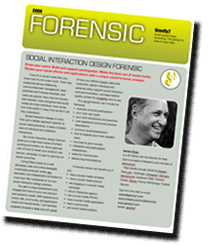This post is a reflection on some questions raised by Adina Levin in a post on
Google Wave dated July. I haven't myself used the product, so this is not a product review but is instead a continuation of some of the thoughts Adina raised around Wave's social models. I'll speak here more to the ongoing innovation in conversation tools rather than attempt even educated guesses as to Wave itself. I should also say that this post is un-premeditated and off the cuff.
Wave is a communication tool. In that, it will be compared to twitter. But there seem to be substantial differences between the two, as many (some) will no doubt have experienced from using Wave. Regardless of Google's strategic interest in launching Wave (as a response to twitter or not), they seem to bear resemblance only in their contributions to the conversational trend in social tools and social media.
Twitter creates a mediated public, and this means that twitter users are not only using it for communication but for social reasons also. As I tried to show in a recent post (
Social media: the attention economy explained), the user's awareness of this public results in
incidental social effects, byproducts, and outcomes.
Communication in twitter is not just a matter of talking to people but of being seen talking by the public — or at least being aware that one's communication may be seen. The tweet itself thus takes on two forms. One, the statement itself, which may be described as communication (what a person says). And secondly, the commodity form of the tweet, which is an artifact of digitally mediated communication and which results in statements being re-distributable.
As I've written elsewhere, this makes many conversational tools a
means of production: of the self, of relationships, of visibility, presence, status, and so on. In the communication age, these tools are an intrinsic part of the attention economy and of the manufacture, if you will, of a mediated self: one that is extended across time and space, represented and captured online.
Note that the "Self" is always extended across time and space through relationships; but media offer the possibility of
representing this extension. This means that distribution becomes as important a factor in a social tool's use as communication (talking with the purpose of reaching understanding with somebody about something).
The tweet as commodity form plays into and allows many social and cultural practices involving social visibility, status, reputation, and other aspects of individual identity and social position. Redistribution of the commodity form of the tweet, as seen in retweeting "
influencers," sharing news, linking to blog posts and sites, announcing one's activities, engaging in
social rituals such as #followfriday, social and event pics, declarations of gratitude — all these social activities are achieved using direct and indirect acts of communication.
They use both forms. Loosely coupled or un-coupled linguistic statements; and the commodity form of the tweet, whereby the tweet is essentially a social object, and the act of distributing it supplements its meaning.
The meaning of an act of communication, the stated meaning of the tweet in other words, is the communicative act. The commodity form is the meaning the tweet has that's not in the statement but obtains from its use. A retweet is a statement retweeted and thus the act of retweeting is a social act which has its own social meanings above and beyond what the retweeted tweet actually says.
Twitter thrives on the supplementary meanings that are produced in the wake of its unique discontinuities: de-coupled conversational turns, out of synch and time, each experienced in a view particular to the user's own selection of followers. In contrast to Wave, twitter is a disaggregated social space. Each of us has his or her own window onto a social world taken in through stretches of thin but durable attention
streamtime.
These social acts, which are virtually unlimited in possibility given twitter's
open structure and lack of social design (no groups, virtually no functional syntax, no navigation besides chronological, etc) result in a highly inefficient social space
rich in ambiguities that are as compelling and engaging as they are frustrating.
My position on this is that ambiguities of social action and intent, as well as of linguistic meanings, are the fuel of conversational media. For the greater the ambiguity of intent and meaning, the more social relationships and interpersonal handling (interaction) has to do. The more it has to do, the richer the social possibilities.
Social conventions and practices supply understanding to compensate for design inadequacies. In short, loss of context is addressed by social action and emerging practices. Practices provide a different type of context, one not of design but of interaction.
Google Wave seems intended to capture conversation in its context. It is not a public social tool, and not likely to engender the types of social visibility, identity, status, and so on that have made twitter what it is. As such, it seems interested in providing a functional improvement to conversation, by means of design, by means of containing the audience, by means of capturing and offering playback of past conversation.
Adina writes: "Wave is a toolset with even more flexibility than a wiki, with even more interactive content. This poses even greater challenges to help people understand how to use it and be productive."
I would object somewhat to the suggestion that conversational tools ought to be designed with productivity in mind. And to the idea that the tool has a way of being used. Conversation itself has structure and organization, both internally (linguistic statements have grammar, syntax, and semantic stabilities) and pragmatically (conversations involve moves, turns, and many selections that expose how participants interpret what's going on).
Adina addresses Wave's threading: "When there are comments interspersed between paragraphs in email/forum threads, it can be difficult for newcomers to get the gist of what has occurred. But there is a time-honored way to bring people up to speed — summarize the conversation to date. The summary has a social purpose, too, it steers the discussion toward a state of current understanding." I beg to differ, again, on the last point. I don't believe there is such a thing as "current understanding."
Conversation is itself an action system. Communication, say a statement, that is not answered is only an observed act of communication.
Communication that is picked up is social action. The act of responding to, or picking up, a statement is an act. It has linguistic meaning (what's said in the response) and it has social meaning (to those participating). So from the perspective of mediated social interaction, conversation is more than reaching consensus ("current understanding") about what's been said so far.
Many participants, in fact, will have relational interest in the conversation to date. Not just what has been said but who said it, to whom, how, and so on. This is the drama and performance of talk, and has a great deal of social relevance to participants as well as to those who use the playback feature.
Adina raises good questions about Wave's social models, and directly poses the matter of groups: "The differences between these models make a vast difference between how the tools are used and what they are good for." Again, I wonder whether groups are even the right design approach in conversational tools. It could be that we need to think in terms of social action, interaction, and conversation rather than groups.
Groups aggregate an audience (participants included in the group), capture attention, provide social inclusion (and exclusion), and create a place or context for communication. Wave might make some of this irrelevant (I would need to use it to better understand design implications and models).
I have a preference for thinking in terms of
frames of experience and interaction, over abstracted social models, and particularly those that imply containers. For in conversational tools, the interactions can have order and organization (for example, they have temporal order: a matter clearly addressed in Wave) without need for audience containers (groups, pages, place). Context can be created ad hoc as messages are threaded, arranged, re-aggregated, and so on.
That's about all I wanted to say. Conversational tools are in part such a rich turn in social media's evolution because the act of talking in front of others, in a form that can be redistributed and stored, will always engage social interests. All statements have a double meaning. That of the statement and that of the act of making the statement. It belongs to communication itself that we can tell the difference between the statement and its production (utterance and the uttering of the utterance). So for this reason, open public social spaces always enjoy the social play of ambiguity: of intended meaning and of the social act of making, circulating, referencing statements (and their authors!).
Wave seems to want to streamline the conversational experience. I cant see how it would possibly relate then to the unique sociality of twitter. That it might offer up possibilities not only for use of conversation, but for meta functionalities derived from the observation, visualization, navigation and
analytics of conversation seems, however very clear. But that would be a different post entirely!
Labels: social interaction design, sxd, twitter



